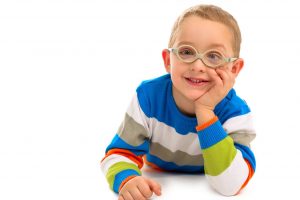
Your toddler may show every sign of good eyesight including the ability to see objects in the distance, however that doesn’t necessarily mean that he or she doesn’t have a vision problem.
Amblyopia is one common eye condition that is often hidden behind the appearance of good eyesight.
Also known as “lazy eye” it usually occurs when the brain begins to ignore the signals sent by one eye, often because that eye is weaker and doesn’t focus properly. Sometimes it can occur in both eyes, in which case it’s called bilateral amblyopia. This eye condition is especially common in preemies, and tends to run in families as well, so it’s important to provide your eye doctor with a complete medical and family history.
There are several factors that can cause amblyopia to develop. These include:
- astigmatism,
- high nearsightedness or farsightedness,
- uneven eye development as an infant,
- congenital cataract (clouding of the lens of the eye),
- strabismus (where the eyes are misaligned or “cross-eyed”)
However in many cases of amblyopia there may be no obvious visible structural differences in the eye. In addition to the fact that the eyes may look normal, vision often appears fine as the brain is able to compensate for the weaker eye by favoring the stronger one. Because of this, many children live with their eye condition for years before it is diagnosed. Unfortunately, as a person ages, the brain loses some of its plasticity (how easy it is to train the brain to develop new skills), making it much harder – if not impossible – to treat amblyopia in older children and adults. That’s why it’s so important for infants and young children to have a thorough eye exam.
Are There Any Signs of Amblyopia?
If you notice your child appears cross-eyed, that would be an indication that it’s time for a comprehensive eye exam to screen for strabismus and amblyopia development.
Preschoolers with amblyopia sometimes show signs of unusual posture when playing, such as head tilting, clumsiness or viewing things abnormally close.
However, often there are no signs or symptoms. The child typically does not complain, as he or she does not know what normal vision should look like. Sometimes the condition is picked up once children begin reading if have difficulty focusing on the close text. The school nurse may suggest an eye exam to confirm or rule out amblyopia following a standard vision test on each eye, though it might be possible to pass a vision screening test and still have amblyopia. Only an eye doctor can make a definitive diagnosis of the eye condition.
So How Do You Know If or When To Book a Pediatric Eye Exam?
Comprehensive eye and vision exams should be performed on children at an early age. That way, hidden eye conditions would be diagnosed while they’re still more easily treatable. An eye exam is recommended at 6 months of age and then again at 3 years old and before entering first grade. The eye doctor may need to use eye drops to dilate the pupils to confirm a child’s true refractive error and diagnose an eye condition such as amblyopia.
Treatment for Amblyopia
Glasses alone will not completely correct vision with amblyopia in most cases, because the brain has learned to process images from the weak eye or eyes as blurred images, and ignore them. There are several non-surgical treatment options for amblyopia. While your child may never achieve 20/20 vision as an outcome of the treatment and may need some prescription glasses or contact lenses, there are options that can significantly improve visual acuity.
Patch or Drops
In order to improve vision, one needs to retrain the brain to receive a clear image from the weak eye or eyes. In the case of unilateral amblyopia (one eye is weaker than the other), this usually involves treating the normal eye with a patch or drops to force the brain to depend on the weak eye. This re-establishes the eye-brain connection with the weaker one and strengthens vision in that eye. If a child has bilateral amblyopia, treatment involves a regimen of constantly wearing glasses and/or contact lenses with continual observation over time.
Your eye doctor will prescribe the number of waking hours that patching is needed based on the visual acuity in your child’s weak eye; however, the periods of time that you chose to enforce wearing the patch may be flexible. During patching the child typically does a fun activity requiring hand eye coordination to stimulate visual development (such as a favorite video game, puzzle, maze etc) as passive activity is not as effective.
The earlier treatment starts, the better the chances are of stopping or reversing the negative patterns formed in the brain that harm vision. Amblyopia treatment with patches or drops may be minimally effective in improving vision as late as the early teen years (up to age 14) but better results are seen in younger patients.
Vision Therapy
Many optometrists recommend vision therapy to train the eyes using exercises that strengthen the eye-brain connection. While success rates tend to be better in children, optometrists have also seen improvements using this occupational therapy type program to treat amblyopia in adults.
The key to improvement through any non-surgical treatment for amblyopia is compliance. Vision therapy exercises must be practiced on a regular basis. Children that are using glasses or contact lenses for treatment, must wear them consistently. Your eye doctor will recommend the schedule of the patching, drops, or vision therapy eye exercise and the best course of treatment.
Amblyopia: Take-home Message
Even if your child is not showing any signs of vision problems, and especially if they are, it is important to have an eye examination with an eye doctor as soon as possible, and on a regular basis. While the eyes are still young and developing, diagnosis and treatment of eye conditions such as amblyopia are greatly improved.